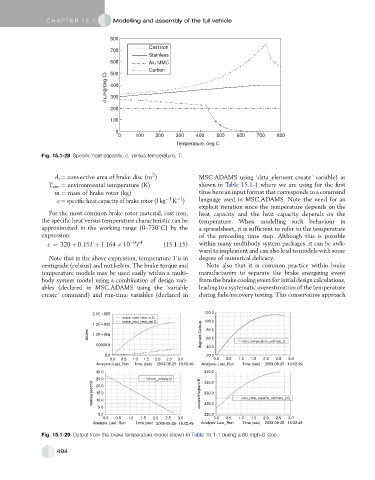Page 486 - Automotive Engineering Powertrain Chassis System and Vehicle Body
P. 486
CHAP TER 1 5. 1 Modelling and assembly of the full vehicle
800
Cast iron
700
Stainless
600 Alu MMC
Carbon
500
c (J/kg/deg C) 400
300
200
100
0
0 100 200 300 400 500 600 700 800
Temperature, deg C
Fig. 15.1-28 Specific heat capacity, c, versus temperature, T.
2
A c ¼ convective area of brake disc (m ) MSC.ADAMS using ‘data_element create’ variable) as
T env ¼ environmental temperature (K) shown in Table 15.1-1 where we are using for the first
m ¼ mass of brake rotor (kg) time here an input format that corresponds to a command
1
c ¼ specific heat capacity of brake rotor (J kg 1 K ) language used in MSC.ADAMS. Note the need for an
explicit iteration since the temperature depends on the
For the most common brake rotor material, cast iron, heat capacity and the heat capacity depends on the
the specific heat versus temperature characteristic can be temperature. When modelling such behaviour in
approximated in the working range (0–730 C) by the a spreadsheet, it is sufficient to refer to the temperature
expression: of the preceding time step. Although this is possible
c ¼ 320 þ 0:15T þ 1:164 10 9 4 (15.1.15) within many multibody system packages, it can be awk-
T
ward to implement and can also lead to models with some
Note that in the above expression, temperature T is in degree of numerical delicacy.
centigrade (celsius) and not kelvin. The brake torque and Note also that it is common practice within brake
temperature models may be used easily within a multi- manufacturers to separate the brake energizing event
body system model using a combination of design vari- from the brake cooling event for initial design calculations,
ables (declared in MSC.ADAMS using the ‘variable leading to a systematic overestimation of the temperature
create’ command) and run-time variables (declared in during fade/recovery testing. This conservative approach
2.0E 005 120.0
brake_rotor_heat_in.Q
brake_rotor_heat_out.Q 100.0
1.5E 005
Joules 1.0E 005 degrees Celsius 80.0
60.0
50000.0 40.0 rotor_temperature_estimate_2
0.0 20.0
0.0 0.5 1.0 1.5 2.0 2.5 3.0 0.0 0.5 1.0 1.5 2.0 2.5 3.0
Analysis: Last_Run Time (sec) 2003-08-25 16:02:49 Analysis: Last_Run Time (sec) 2003-08-25 16:02:49
30.0 340.0
25.0 vehicle_velocity.Q 335.0
metres/second 15.0 Joules/kilogram/K 330.0 rotor_heat_capacity_estimate_2.Q
20.0
10.0
5.0 325.0
0.0 320.0
0.0 0.5 1.0 1.5 2.0 2.5 3.0 0.0 0.5 1.0 1.5 2.0 2.5 3.0
Analysis: Last_Run Time (sec) 2003-08-25 16:02:49 Analysis: Last_Run Time (sec) 2003-08-25 16:02:49
Fig. 15.1-29 Output from the brake temperature model shown in Table 15.1-1 during a 60 mph–0 stop.
494

